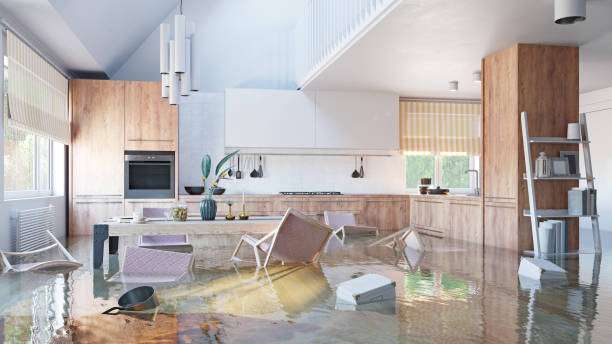
Water damage is one of the most common reasons homeowners file insurance claims, but whether your home insurance policy covers it depends on the cause of the damage. While standard home insurance typically provides some coverage for water damage, there are exclusions and limitations to be aware of. This article explores specific scenarios, common exclusions, and how additional coverage options like flood insurance can protect your property.
When Does Home Insurance Cover Water Damage?
In general, home insurance policies cover sudden and accidental water damage caused by events within the home. Here are some common examples of covered scenarios:
Burst Pipes or Plumbing Failures
If a pipe suddenly bursts or a plumbing fixture malfunctions, resulting in water damage, your home insurance policy will likely cover the cost of repairs and damage to the affected areas.
Example: A frozen pipe bursts during winter, flooding your living room. Most policies will cover the water damage, but not the cost of replacing the pipe itself.
Accidental Overflow or Discharge
Damage caused by accidental overflows, such as a washing machine hose suddenly bursting or a water heater leaking, is typically covered.
Example: If your water heater leaks and damages your flooring, your policy will likely pay for repairs or replacement.
Rain or Storm-Related Damage
If rain enters your home through a damaged roof or broken window caused by a covered peril (like wind or hail), the resulting water damage is generally covered.
Example: High winds tear off shingles from your roof, allowing rainwater to damage your attic and ceiling. This would fall under your policy’s protection.
What Water Damage is NOT Covered by Home Insurance?
Standard home insurance policies often exclude specific types of water damage, particularly when the damage results from neglect, gradual wear and tear, or external flooding.
Flood Damage
Flooding caused by natural disasters, such as heavy rain, overflowing rivers, or storm surges, is not covered under standard home insurance policies.
Solution: To protect against these risks, you need separate flood insurance through the National Flood Insurance Program (NFIP) or private insurers.
Gradual Damage or Neglect
Damage resulting from slow leaks or poor maintenance, such as a dripping pipe or a poorly sealed window, is not covered. Insurers expect homeowners to perform routine maintenance to prevent such issues.
Example: If a pipe has been leaking for months and causes mold growth, your claim will likely be denied due to lack of maintenance.
Sewer or Drain Backups
Water damage caused by backed-up sewer lines or drains is typically excluded unless you’ve purchased additional coverage, often referred to as a sewer backup endorsement.
Example: If heavy rainfall overwhelms your sewer system, causing water to back up into your basement, you’ll need a sewer backup policy to cover the damage.
Intentional Acts or Negligence
If the damage occurs because of intentional actions or negligence, it won’t be covered. For instance, if you leave a faucet running and it floods your bathroom, your insurer may reject the claim.
Additional Coverage Options for Water Damage
If you live in a high-risk area or want extra peace of mind, consider these additional coverage options to protect your home:
Flood Insurance
Flood insurance is essential for homeowners in flood-prone regions. It covers damages caused by rising water or overflowing rivers, which are excluded from standard policies.
Coverage Includes:
- Structural damage to your home.
- Damage to electrical and plumbing systems.
- Loss of personal belongings due to flooding.
How to Get It:
You can purchase flood insurance through the NFIP or private insurers. Note that there’s usually a 30-day waiting period before coverage begins.
Sewer Backup Coverage
Adding sewer or drain backup coverage to your policy can protect against costly water damage from clogged or overwhelmed systems.
Why It’s Important:
A single sewer backup incident can cause thousands of dollars in damage, especially to finished basements or expensive plumbing fixtures.
Water Damage Endorsements
Some insurers offer endorsements that expand water damage coverage to include scenarios like gradual leaks or sump pump failures.
Pro Tip:
Discuss your needs with your insurance agent to determine whether these endorsements are worth the extra premium.
How to Prevent Water Damage
Taking preventive measures can help you avoid costly repairs and the hassle of filing insurance claims. Here are some tips to protect your home:
- Inspect Pipes and Plumbing: Regularly check for leaks, corrosion, or weak spots in your plumbing system.
- Clean Gutters and Downspouts: Keep gutters free of debris to ensure proper drainage during rainstorms.
- Install a Sump Pump: A sump pump can prevent water accumulation in your basement during heavy rains.
- Seal Cracks: Seal any foundation cracks or gaps to prevent water seepage.
- Use Smart Devices: Consider installing water leak detectors or automatic shut-off valves for early detection and damage prevention.
What to Do If Water Damage Occurs
If your home sustains water damage, act quickly to minimize losses and start the claims process:
- Document the Damage: Take photos or videos of the affected areas before cleaning or repairing anything.
- Contact Your Insurer: Notify your insurance provider as soon as possible and provide them with detailed information about the incident.
- Mitigate Further Damage: Take steps to prevent further damage, such as stopping the water source or removing wet items.
- Save Receipts: Keep receipts for temporary repairs or replacements, as your insurer may reimburse you.
Conclusion
Home insurance can provide valuable protection against water damage, but understanding what is and isn’t covered is crucial. While standard policies cover sudden and accidental damage caused by events like burst pipes or storms, exclusions such as flood damage and gradual leaks highlight the importance of additional coverage options. By staying informed and taking preventive measures, you can safeguard your home and make the most of your insurance policy.
Read More…
FAQs
- Does home insurance cover water damage from a leaking roof?
Yes, if the leak is caused by a covered peril, such as a storm. Damage due to neglect, however, is not covered. - Can I add flood insurance to my existing home insurance policy?
Flood insurance is a separate policy, but it can complement your home insurance for complete protection. - How can I reduce the risk of water damage?
Regular maintenance, installing water leak detectors, and cleaning gutters are effective ways to prevent damage. - Is mold damage covered under home insurance?
Mold damage caused by a covered water event may be included, but damage from neglect or long-term leaks is excluded. - What is the average cost of flood insurance?
Flood insurance costs vary based on location and risk level, but premiums typically range from $400 to $1,200 annually.
